Body length: 11–44 mm.
Eyes: eye interommatidial setaeseta:
a sclerotized hair-like projection of the cuticle
absent, eye deeply emarginateemarginate:
notched at the margin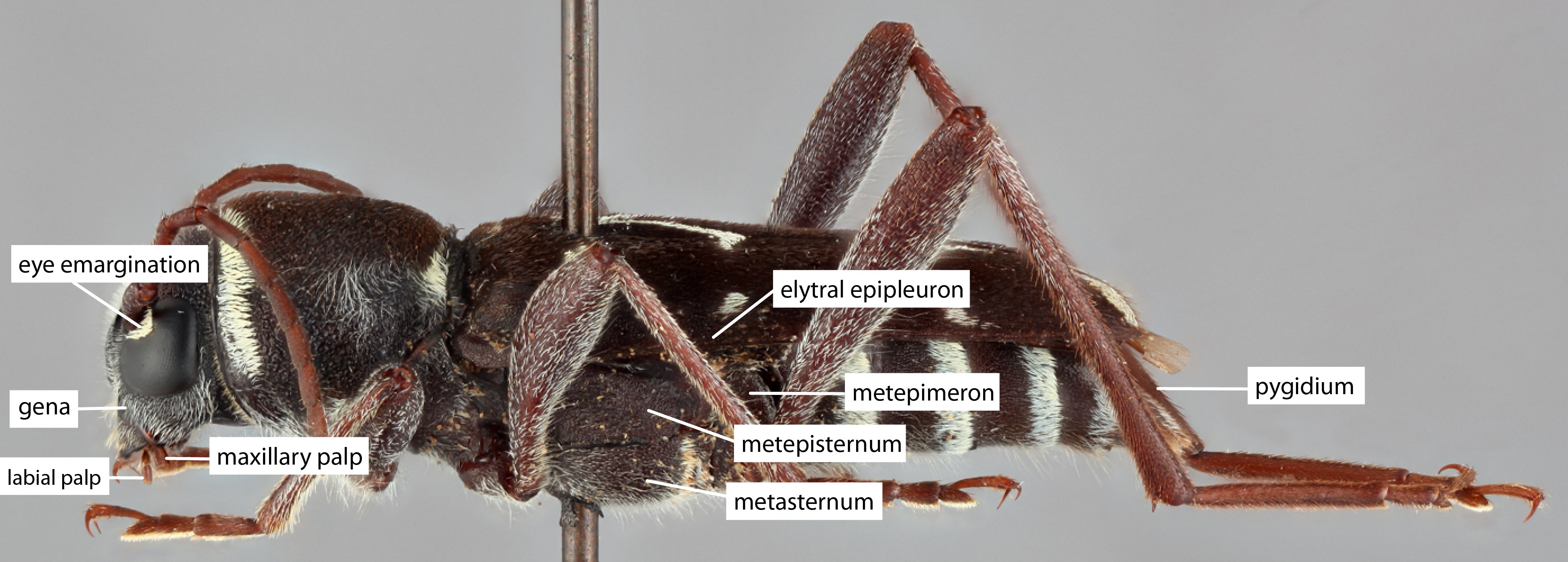 > half width, eye ommatidial density fine, rarely coarse.
> half width, eye ommatidial density fine, rarely coarse.
Antennaeantenna:
in larval and adult insects, paired segmented appendages, borne one on each side of the head, functioning as sense organs and bearing a large number of sensilla
: antennal length reaching/surpassing end of body, antennal flagellar segments elongateelongate:
much longer than wide
, scapescape:
the first proximal segment of the antenna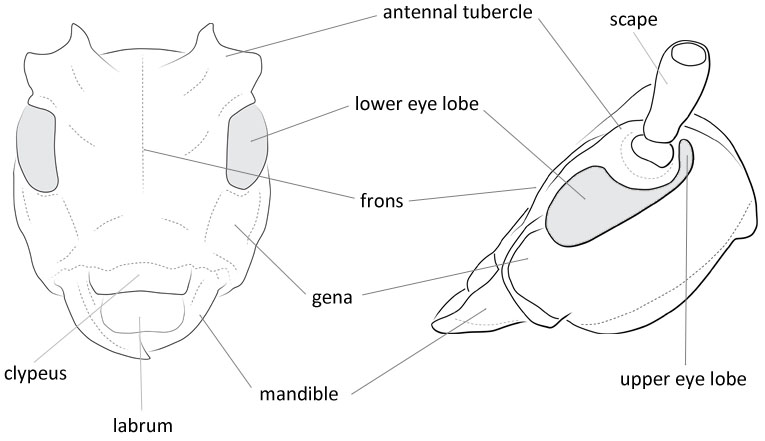 cicatrix (scar) at apexapex:
cicatrix (scar) at apexapex:
end of any structure distad to the base
, antennal segment 3 > scapescape:
the first proximal segment of the antenna .
.
Pronotumpronotum:
the upper and dorsal part of the prothorax
: pronotumpronotum:
the upper and dorsal part of the prothorax
shape transversetransverse:
broader than long
, pronotumpronotum:
the upper and dorsal part of the prothorax
lateral armature acute spinespine:
a protuberance with an acute (sharp) distal end
or blunt tubercule.
Prosternum: prosternal processprosternal process:
a posterior extension of the prosternum between the coxae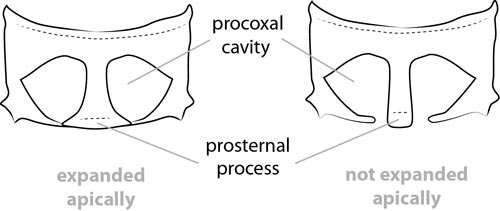 dilated at apexapex:
dilated at apexapex:
end of any structure distad to the base
, procoxal cavities open posteriorly or closed posteriorly.
Elytraelytron:
the leathery forewing of beetles, serving as a covering for the hind wings, commonly meeting opposite elytron in a straight line down the middle of the dorsum in repose
: elytral length reaching or close to end of abdomen, elytral apicesapex:
end of any structure distad to the base
rounded or truncatetruncate:
cut off squarely at the tip
or with tooth or spinespine:
a protuberance with an acute (sharp) distal end
, elytral color black, elytral color pattern present or absent.
Legs: visible tarsomerestarsomere:
subdivision or article of the tarsus, usually numbering from two to five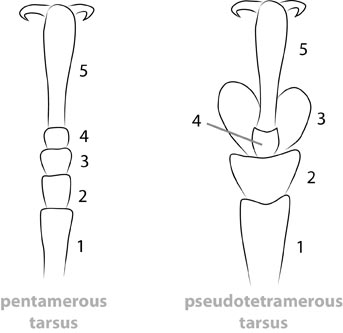 : 4, femora slender, protibial spursprotibial spur:
: 4, femora slender, protibial spursprotibial spur:
sclerotized spine(s) located at the distal tibia; can be single, double, or absent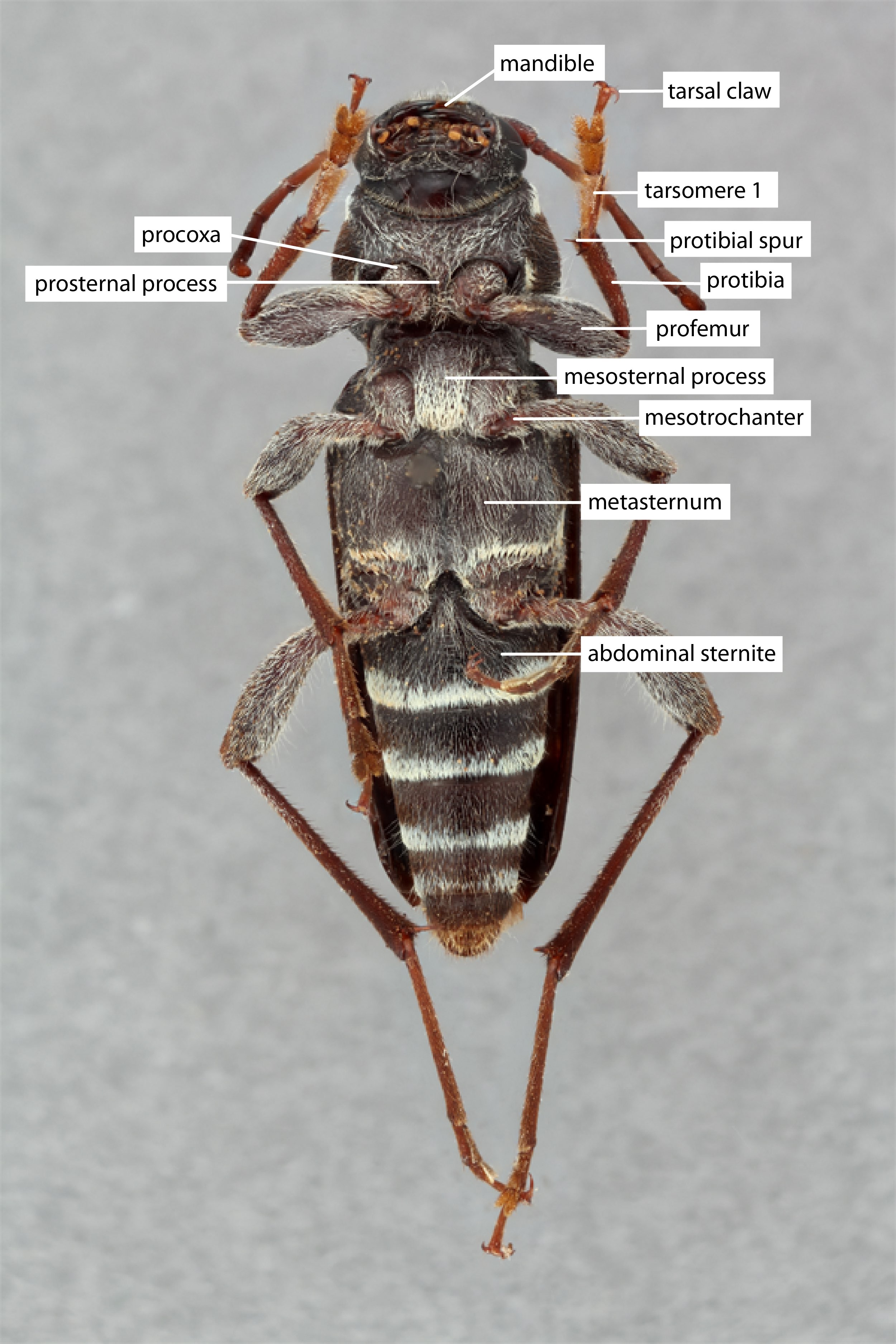 : 2, tarsal clawstarsal claw:
: 2, tarsal clawstarsal claw:
usually paired claws of the pretarsus, at the distal end of the leg simple.
simple.
Form moderate-sized to large, tapering to subparallel. Head with front rectangular, median line shallow to antennal tubercles; genaegena:
the part of the cranium on each side below the eye elongate, divergentdivergent:
elongate, divergentdivergent:
spreading out from a common base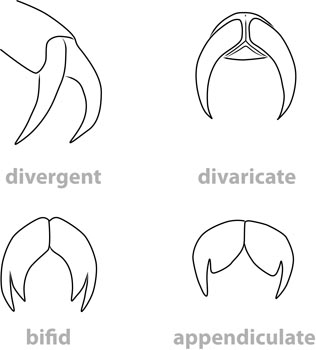 to subparallel; mandibles relatively long, arcuatearcuate:
to subparallel; mandibles relatively long, arcuatearcuate:
arched or bow-like
at apexapex:
end of any structure distad to the base
, apicesapex:
end of any structure distad to the base
acute; palpi unequal, slender, apical segments slender; eyes rather finely faceted, deeply emarginateemarginate:
notched at the margin , upper lobelobe:
, upper lobelobe:
a rounded projection or protuberence
small; antennaeantenna:
in larval and adult insects, paired segmented appendages, borne one on each side of the head, functioning as sense organs and bearing a large number of sensilla
about twice the body length in males, longer than body in females, scapescape:
the first proximal segment of the antenna robust, cylindricalcylindrical:
robust, cylindricalcylindrical:
shaped like a cylinder, parallel sided
, with a strong cicatrixcicatrix:
a scar; a scar-like structure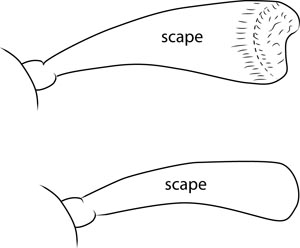 at apexapex:
at apexapex:
end of any structure distad to the base
, third segment of males robust, much longer than scapescape:
the first proximal segment of the antenna , segments in males usually finely, densely asperate, outer segments usually with small, apical poriferous areas. Pronotumpronotum:
, segments in males usually finely, densely asperate, outer segments usually with small, apical poriferous areas. Pronotumpronotum:
the upper and dorsal part of the prothorax
as long as broad, sides strongly tuberculate, tubercles acute, apicesapex:
end of any structure distad to the base
usually rounded; apexapex:
end of any structure distad to the base
and basebase:
the part of any appendage or structure that is nearest the body
shallowly, transversely impressed; prosternum excavated, intercoxal process expanded at apexapex:
end of any structure distad to the base
, coxal cavities open or closed behind; mesosternummesosternum:
sternum of the mesothorax
with intercoxal process slightly arcuatearcuate:
arched or bow-like
, coxal cavities wide open to epimeronepimeron:
the posterior division of a thoracic pleuron, marked anteriorly by the pleural suture ; metepisternummetepisternum:
; metepisternummetepisternum:
the episternal portion of the pleuron on the posterior thoracic segment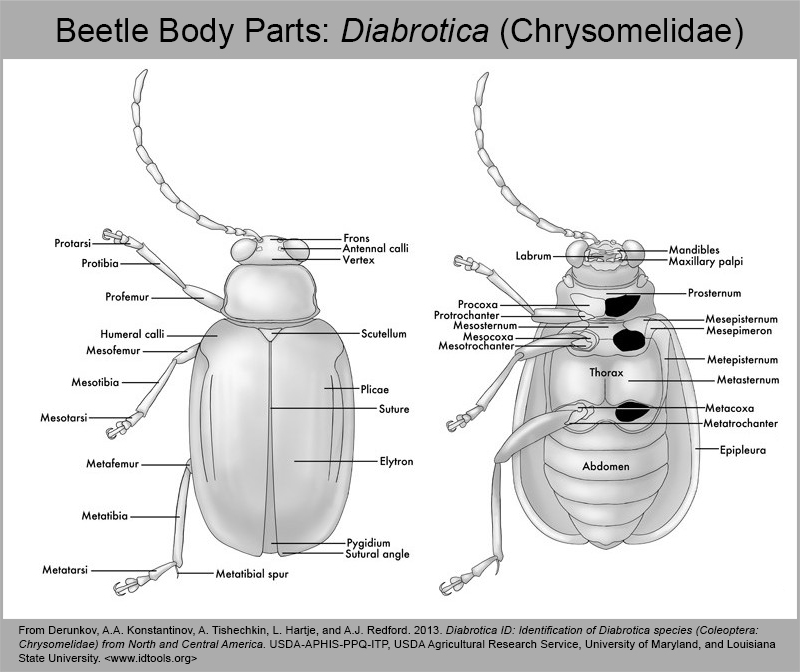 tapering posteriorly. Elytraelytron:
tapering posteriorly. Elytraelytron:
the leathery forewing of beetles, serving as a covering for the hind wings, commonly meeting opposite elytron in a straight line down the middle of the dorsum in repose
at least twice as long as broad; basebase:
the part of any appendage or structure that is nearest the body
often asperate; apicesapex:
end of any structure distad to the base
rounded, sutural angle often angulate to dentate. Legs slender, front pair usually elongateelongate:
much longer than wide
in males; tarsitarsus:
the leg segment distal to the apex of the tibia, bearing the pretarsus; consists of one to five tarsomeres (including pretarsus)
short, third segment of posterior pair cleft almost to basebase:
the part of any appendage or structure that is nearest the body
. Abdomen with last segment tufted apically in females (Linsley and Chemsak 1985).
Anoplophora, Goes, Monochamus sensu lato
Lateral pronotal spines are medium-sized and acute but blunted in conifer feeders, most angiosperm feeding Monochamus have large and sharp pronotal spines. Goes has elytraelytron:
the leathery forewing of beetles, serving as a covering for the hind wings, commonly meeting opposite elytron in a straight line down the middle of the dorsum in repose
punctate and lightly asperate at basebase:
the part of any appendage or structure that is nearest the body
(Monochamus coarsely rugoserugose:
wrinkled
), never armed at the apicesapex:
end of any structure distad to the base
, antennaeantenna:
in larval and adult insects, paired segmented appendages, borne one on each side of the head, functioning as sense organs and bearing a large number of sensilla
with smooth segments and ≤ 1.5x body length, front legs not longer in males, and smaller lateral pronotal spines.
Nearctic south to Honduras; Palearctic
Eurasian species intercepted in USA and vice versa
Pinaceae; broadleaf trees
18 species (10 Old World, 8 New World). Taxonomy is messy in this group, but the genus name belongs to the conifer-feeding species. There are currently other species using the name in other regions of the world. Species of the conifer-feeding group are treated in the Monochamus section of this tool.
Monachammus Gray, 1832 (misspelling)
Ceratades Gistel, 1834
Monohammus Dejean, 1835 (misspelling)
Meges Pascoe, 1866
Monochamus Dejean, 1821, Cat. Coll. Coleop. Dejean, p. 106